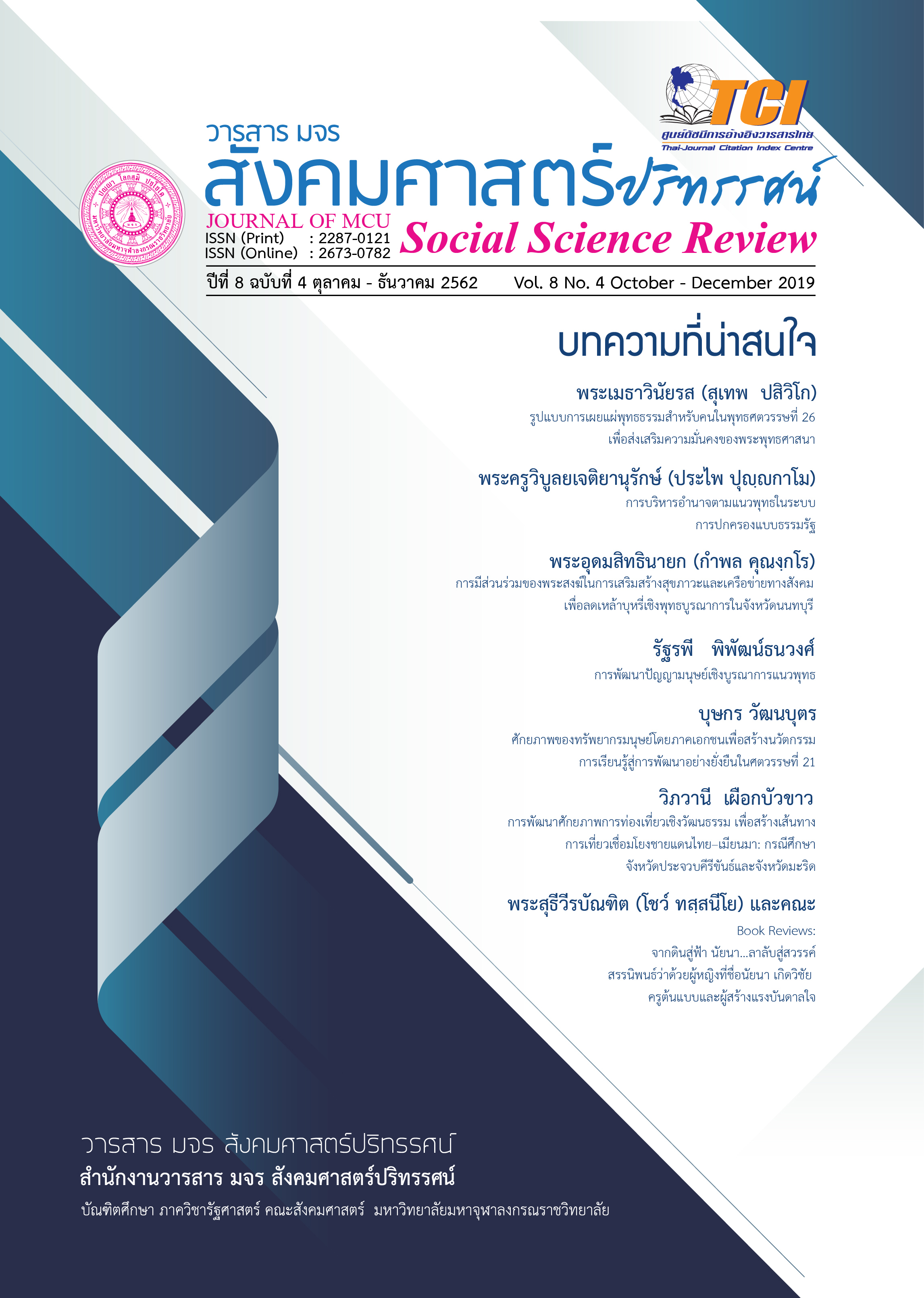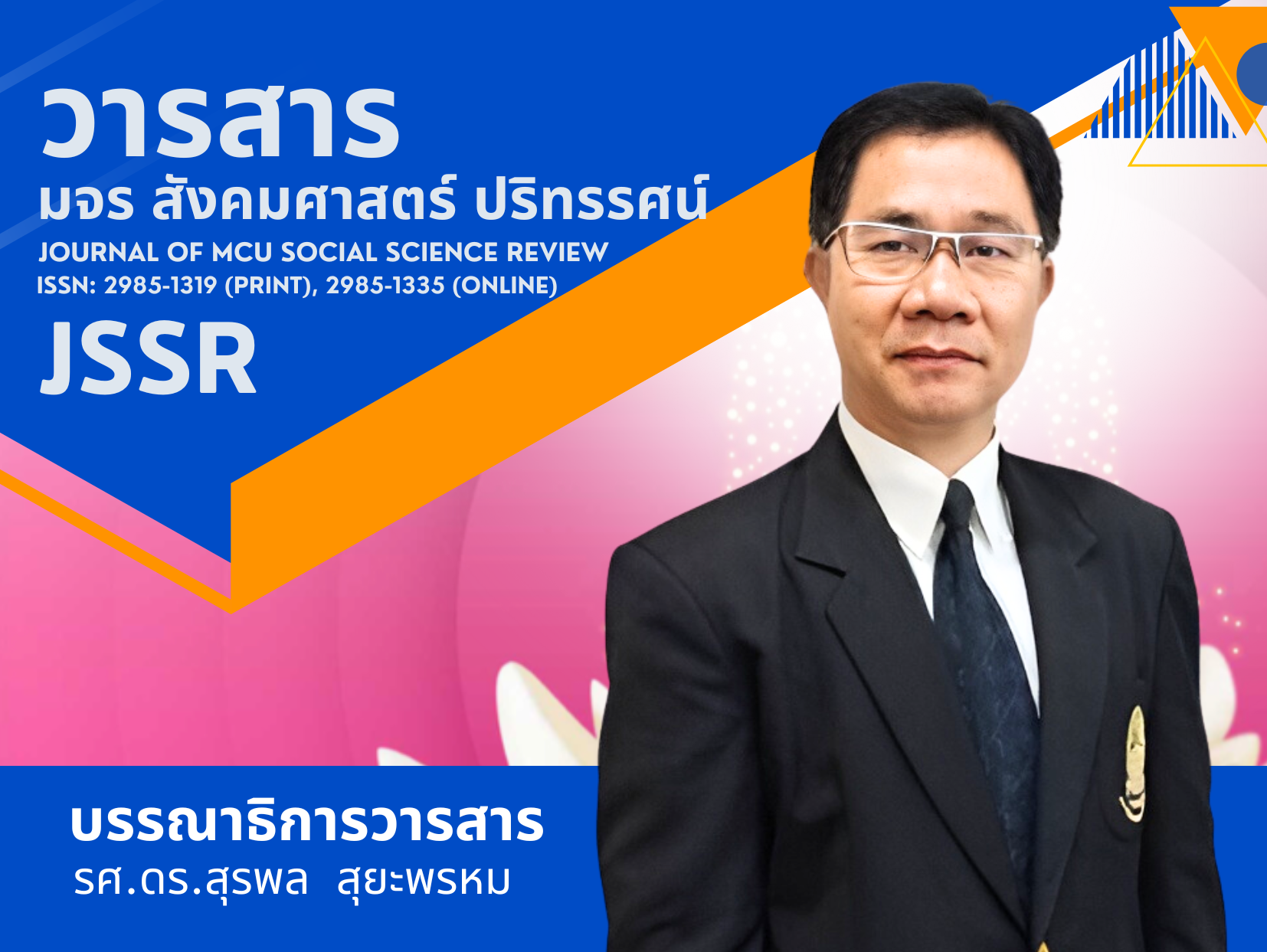THE MODEL OF PROPAGATION OF BUDDHISM FOR PEOPLE IN THE TWENTY SIXTH BUDDHIST CENTURY TO PROMOTE THE PERMANENCE OF BUDDHISM
Keywords:
Model, Dhamma Dissemination, The Sustainable of BuddhismAbstract
The aims of this research were as follows, 1) To study the Dhamma dissemination for people in 26th Buddhist century to promote the permanence of Buddhism and 2) To develop and present the model for Dhamma dissemination for people in 26th Buddhist century to promote the permanence of Buddhism The
instruments for data collection were questionnaire, in-depth interview and focus group. The samples were composed of 1) Dissemination monks for 4,997 persons, sampling for 357 persons, and 2) scholar group for 30 persons, to present the finding by data descriptive analysis.The results of research were found as follows:1) The state for Dhamma dissemination for Buddhist in 26th Buddhist century to promote the permanence of Buddhism by overview was at more level when classified in each aspect found that
the aspect of monk was the highest mean, the aspect of dissemination, the aspect of media, the aspect of plan and policy and the aspect of networking all were at more level and the aspect of promotion was at moderate level. 2) The model for Dhamma dissemination for Buddhist in 26th Buddhist century to promote the permanence of Buddhism as following. 2.1) The aspect of networking, the make a networking by proactive through government organization and private units for moving Dhamma dissemination by integrations with society or personally in and out nations for knowledge changing and making networking together for proactive of local passing by local scholar, community and local. 2.2) The aspect of
Dissemination methodology, the make method and form of dissemination with variety of procedures for accordance with necessary of multi-culture society and concepts and aims according to Buddha’s teaching to emphasize Buddhists have awareness in teaching principles as righteousness. 2.3) The aspect of media, to
promote on technology, IT. to use in dissemination mass communication for insider people all purposes by making form or innovation as modernization to apply in Dhamma dissemination passing on online media i.e. face book, Youtube and line application etc. 2.4) The aspect of monk, to promote and develop personal whodisseminated Dhamma to have more skills in Dhamma dissemination which are accordance with learning in the 21st century by emphasized on characteristic development and high competency for more efficiency in working on dissemination as well as possible. 2.5) The aspect of promotion, in and out Sangha unit and
government must promote Dhamma dissemination in country and out of country as appearance and to promote for all levels of Dhammatayat and promote temple in competency for learning and religious activities practice on Buddhist dissemination for responding of need for people’s learning. And 2.6) The aspect of planning and policy, to develop the models which are emphasized on running of policy to field
work as appearance in all aspects with participation of all units under government or private and making the Buddhism strategy in 4.0 for accordance with national strategy for 20 years of government.
References
Phra Daonue Bootsitha. (2014). Formingand Managinga Networkof a Buddhist Community in Banpobthamnamsuk Community, Thungsalieng District,Sukhothai (Master of Thesis). National Institute of Development Administration.
Phrakrukhositsangpitak (Pravet Thathan). (2018). Strategies for Proactive Buddhism Propagation of Thai Sangha in Present Time (Doctor of Thesis). Graduate School : Mahachulalongkornrajavidyalaya University.
Phrakrukhositsangpitak (Pravet Thathan). (2017,September – December). Strategies for Proactive Buddhism Propagation of Thai Sangha in Present Time. Dhammathas Academic Journal, 17(3), 212-223.
Phramaha Sayan Nammuaeng. (1995). The Role of Monks on Teaching Buddhism : A Case Study of The Primary Schools in Bangkok (Doctor of Thesis). Graduate School : Mahachulalongkornrajavidyalaya. University.
Phramanit Jotidhammo (Accachart). (2009). A Study of Problems and Solutions for the Performance of the School Morality Teaching Monk in Si Sa Kat (Doctor of Thesis). Graduate School : Mahachulalongkornrajavidyalaya University.
Punnudda Noppanawan. (1990). A study of the Dhamma Communication Process of Thai Buddhist Institute (Master of Thesis). Graduate School: Chulalongkorn University.
School Morality Teaching Monk Project. (2006). Strategic Plan of School Morality Teaching Monk Project. Nakhon Prathom : Mahamakut Buddhist University.
Sukusar Nuntong. (2017). Quality Development of Academic Services Unit Management of Machulalongkornrajavidayalaya University (Doctor of Thesis). Graduate School : ahachulalongkornrajavidyalaya University.
Thawatchai Chinsongteerapanich. (2017). The Development of Competency in Propagation of the Temple Abbots.Thesis Graduate School : Mahachulalongkornrajavidyalaya University.
The Office of National Buddhism. (2010). The Performance of the School Morality Teaching Monks (Research Report). Nakhon Prathom : Printing of Religion Affairs Department.
Downloads
Published
How to Cite
Issue
Section
License
In order to conform the copyright law, all article authors must sign the consignment agreement to transfer the copyright to the Journal including the finally revised original articles. Besides, the article authors must declare that the articles will be printed in only the Journal of MCU Journal of Social Sciences. If there are pictures, tables or contents that were printed before, the article authors must receive permission from the authors in writing and show the evidence to the editor before the article is printed. If it does not conform to the set criteria, the editor will remove the article from the Journal without any exceptions.





